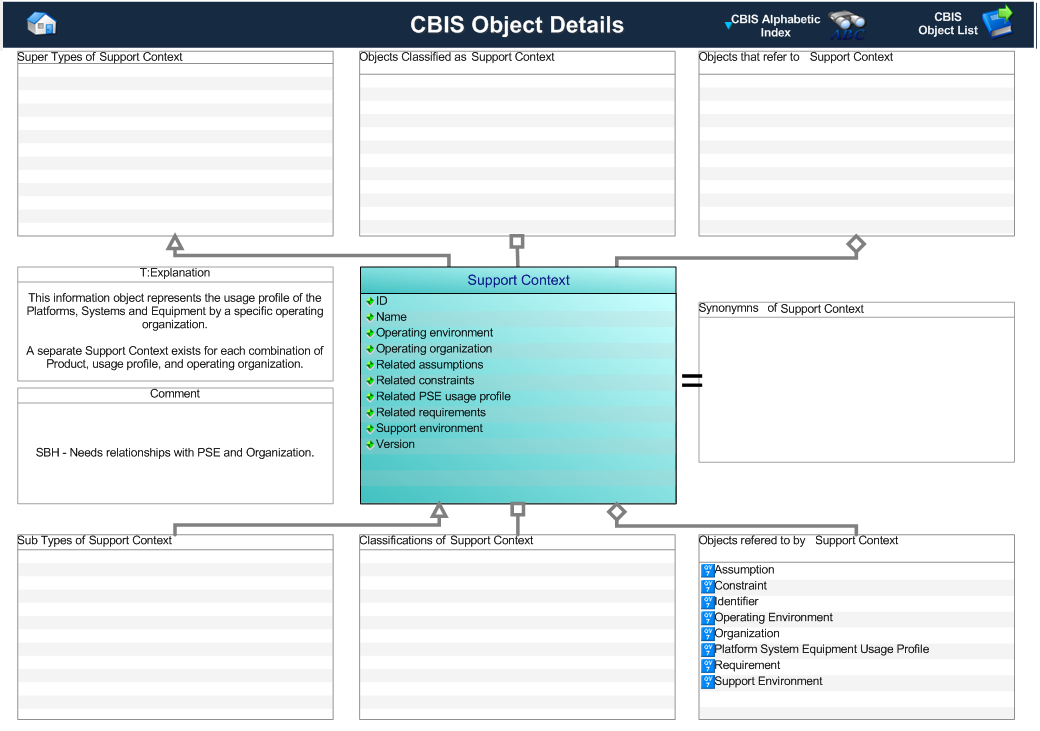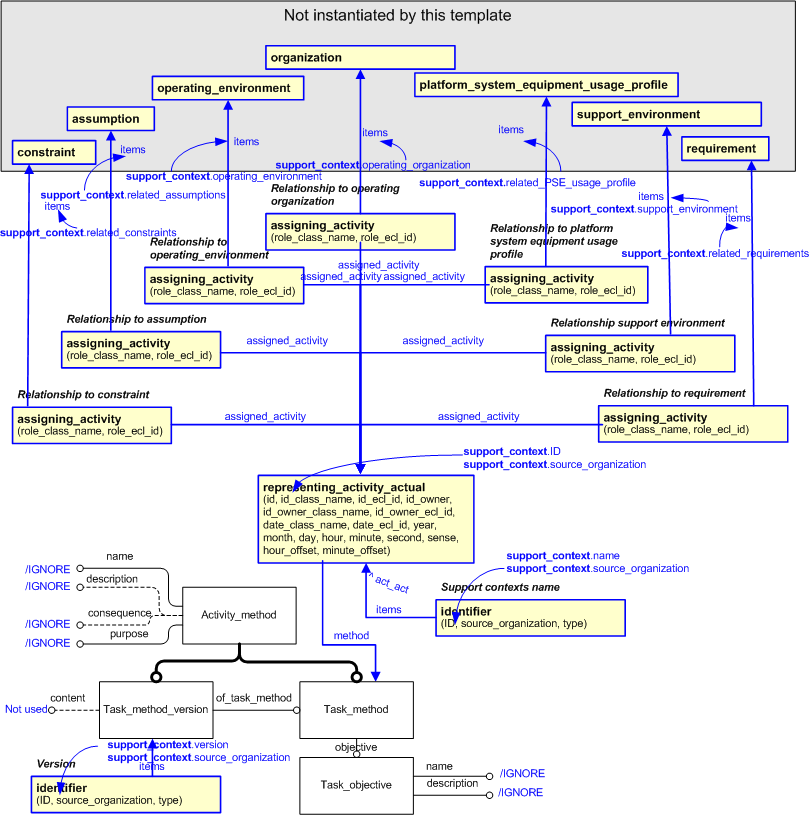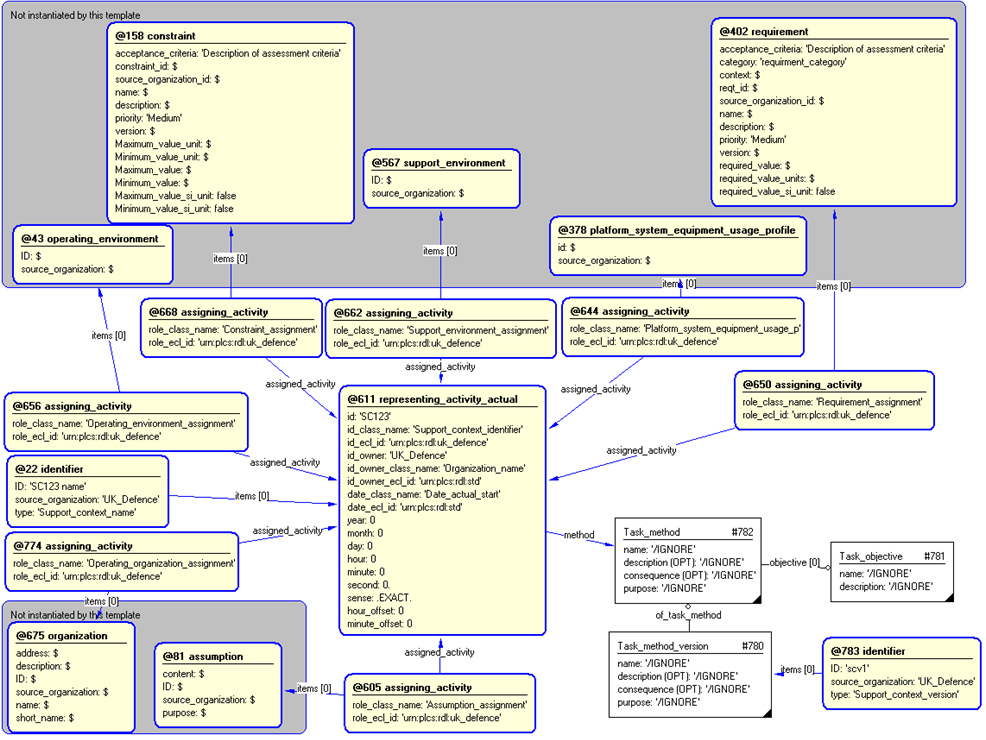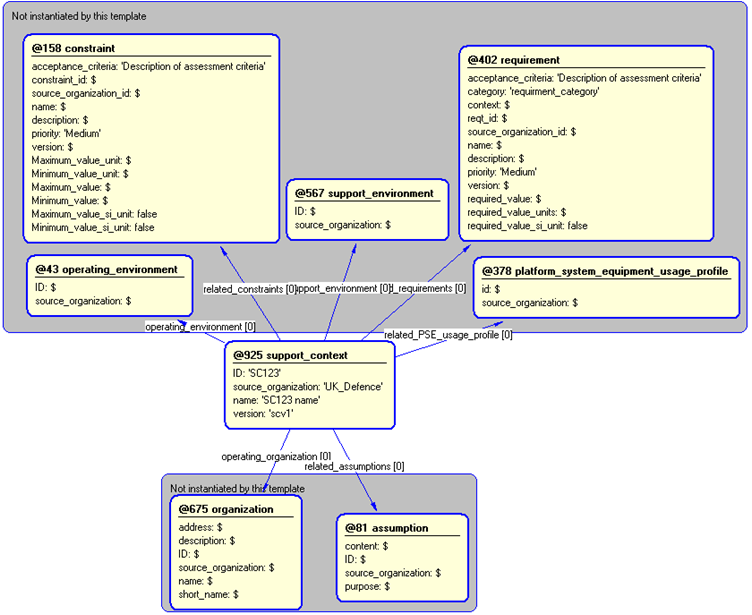Template:— support_context (sup_con)
Context:— UK_Defence |
Date: 2009/04/17 11:58:03
Revision: 1.5
|
This section specifies the template support_context.
NOTE
The template has been defined in the context of
UK_Defence.
Refer to the business context for details of related templates.
NOTE
An explanation of a template and the associated instantiation path is
provided in the
Template overview
section.
This template describes how to represent the usage profile of the Platforms, Systems and
Equipment by a specific operating organization. A separate Support Context exists for each
combination of Product, usage profile, and operating organization
NOTE
The mapping to activity may be reviewed after the release of PLCS Ed. 2
The support context business object is used by those UK_Defence Data Exchange
Specifications that require information about the usage profile of the Platforms, Systems and
Equipment by a specific operating organization
Figure 1 — Graphical Representation for Business Object Support Context
Support Context:
The definition of an Support Context object is:
Data about the usage profile of a Product (Platforms, Systems and Equipment) by a specific operating organization
|
Attribute name
|
Attribute description
|
Attribute type
|
Optionality
|
| ID |
This is the identifier of the support context. |
Identifier |
Mandatory |
| Name |
This is the name of the support context |
Identifier |
Mandatory |
| Operating environment |
This is the reference to the operating environment that forms part of the support context. |
Relationship to Operating environment |
Mandatory |
| Operating organization |
This is the reference to the intended operating organization which forms part of the support . |
Relationship to Organization |
Mandatory |
| Related assumptions |
This is the reference to the assumptions from which the support context has been derived. |
Relationship to Assumption |
Optional(0:?) |
| Related constraints |
This is the reference to the constraints imposed upon definition of the support context. |
Relationship to Constraint |
Optional(0:?) |
| Related PSE usage profile |
This is the reference to the platform, system and equipment usage profile which form part of the support . |
Relationship to Platform System Equipment Usage Profile |
Mandatory |
| Related requirements |
This is the reference to the requirements from which the support context has been derived. |
Relationship to Requirement |
Mandatory(1:?) |
| Support environment |
This is the reference to the support environment that forms part of the support context. |
Relationship to Support environment |
Mandatory |
| Version |
This is the version of the support context. |
Intrinsic |
Mandatory |
Table 1 — Support Context attribute details
The EXPRESS-G diagram in
Figure
2
shows the templates and EXPRESS entities that are required
to represent the template
"support_context".
The text highlighted in blue shows the template parameters.
Figure 2 — An EXPRESS-G representation of the Information model for support_context
The graphic for the template to be used in other EXPRESS-G diagrams
is shown in Figure
3
below.
Figure 3 — The graphical representation of the support_context template
The following input parameters are defined for this template:
This is the identifier of the support_context.
The organization that created the support_context. Additionally
a Person or Information System could be defined when either of these are the source; see Identifier template.
This is the name of the support_context.
This is the reference to the operating environment that forms part of the support context.
The item to which the operating environment is assigned
This is the reference to the assumptions from which the support context has been derived.
This is the reference to the constraints imposed upon definition of the support context.
This is the reference to the platform, system and equipment usage profile which form part of the support .
This is the reference to the requirements from which the support context has been derived.
This is the reference to the support environment that forms part of the support context.
This is the version of the support context.
The following reference parameters are defined for this template:
Allow the
Activity_actual
entity instantiated in this path to be referenced when this template is used.
%^target = $support_context.act_act%
Allow the
Activity_method
entity instantiated in this path to be referenced when this template is used.
%^target = $support_context.method%
The following parameter combinations specify a uniqueness constraint:
Unique constraint: Support Context
The instantiation path shown below specifies the entities that are to be
instantiated by the template.
A description of templates and the syntax for the instantiation path is
provided in the
Templates Help/Information section.
%^objective =
Task_objective%
Task_objective.name = '/IGNORE'
Task_objective.description = ''/IGNORE'
%^method =
Task_method%
Task_method.name = '/IGNORE'
Task_method.description = ''/IGNORE'
Task_method.consequence = '/IGNORE'
Task_method.purpose = '/IGNORE'
Task_method.objective ->
^objective
%^method_version =
Task_method_version%
Task_method_version.name = '/IGNORE'
Task_method_version.description = ''/IGNORE'
Task_method_version.consequence = '/IGNORE'
Task_method_version.purpose = '/IGNORE'
Task_method_version.of_task_method ->
^method
-- Version /
identifier(
ID=@version,
source_organization=@source_organization,
type='support_context_version',
items=^method_version)/
-- representing_activity_actual (mandatory) /
representing_activity_actual(
id=@ID,
id_class_name='Support_context_identifier',
id_ecl_id='urn:plcs:rdl:uk_defence',
id_owner=@source_organization,
id_owner_class_name='Organization_name',
id_owner_ecl_id='urn:plcs:rdl:std',
method=^method,
date_class_name='Date_actual_start',
date_ecl_id='urn:plcs:rdl:std',
year='0',
month='0',
day='0',
hour='0',
minute='$',
second='$',
sense='.EXACT.',
hour_offset='0',
minute_offset='$')/
%^act_act = $representing_activity_actual.act_act%
-- Name (mandatory) /
identifier(
ID=@name,
source_organization=@source_organization,
type='Name',
items=^act_act)/
-- [optional Related assumptions] /
assigning_activity(
role_class_name='Assumption_assignment',
role_ecl_id='urn:plcs:rdl:uk_defence',
assigned_activity=^act_act,
items=@related_assumptions)/
-- [optional Related constraints] /
assigning_activity(
role_class_name='Constraint_assignment',
role_ecl_id='urn:plcs:rdl:uk_defence',
assigned_activity=^act_act,
items=@related_constraints)/
-- Related operating environment /
assigning_activity(
role_class_name='Operating_environment_assignment',
role_ecl_id='urn:plcs:rdl:uk_defence',
assigned_activity=^act_act,
items=@operating_environment)/
-- Related operating organization /
assigning_activity(
role_class_name='Operating_organization_assignment',
role_ecl_id='urn:plcs:rdl:uk_defence',
assigned_activity=^act_act,
items= @operating_organization)/
-- Related support environment /
assigning_activity(
role_class_name='Support_environment_assignment',
role_ecl_id='urn:plcs:rdl:uk_defence',
assigned_activity=^act_act,
items=@support_environment)/
-- Related requirement /
assigning_activity(
role_class_name='Requirement_assignment role_ecl_id='urn:plcs:rdl:uk_defence',
assigned_activity=^act_act,
items=@related_requirements)/
-- Related PSE usage profile /
assigning_activity(
role_class_name='Platform_system_equipment_usage_profile_assignment',
role_ecl_id='urn:plcs:rdl:uk_defence',
assigned_activity=^act_act,
items=@related_PSE_usage_profile)/
The following entities are instantiated with attributes as specified:
The instance diagram in Figure
4
shows an example of the EXPRESS entities and templates that are instantiated by the template:
/support_context(ID='SC123', source_organization='UK_Defence', Name='SC123 name', operating_environment='@43', operating_organization='@675', related_assumptions='@81', related_constraints='@158', related_PSE_usage_profile='@378', related_requirements='@402', support_environment='@567', version='scv1')/
(an illustration of the consolidated support_context template is shown in
Figure
5 below.)
Figure 4 — Entities instantiated by support_context template
The instance diagram in
Figure
5
shows the graphic symbol for the template that is to be
used in other instance diagrams. The example template is:
/support_context(ID='SC123', source_organization='UK_Defence', Name='SC123 name', operating_environment='@43', operating_organization='@675', related_assumptions='@81', related_constraints='@158', related_PSE_usage_profile='@378', related_requirements='@402', support_environment='@567', version='scv1')/
Figure 5 — Instantiation of support_context template
Characterizations
No common characterizations of the template
support_context
have been identified. However, the ISO 10303-239 EXPRESS model
may enable other assignments to the entities instantiated by the template.




